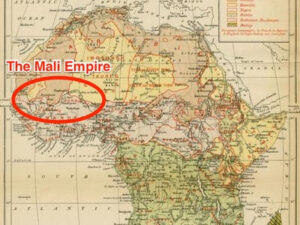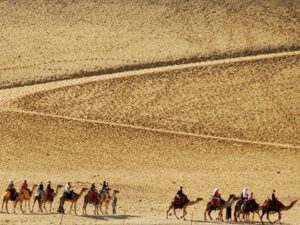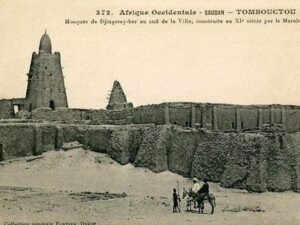Musa 1 of Mali also spelled as Mousa was at times called Kankan Musa. He was also referred to as Mansa (emperor) Musa. He died in 1332. Mansa Musa was the emperor of the West African Empire of Mali. He ascended to the throne in 1307. He was Emperor from 1307 to 1332.

Source: The New York Public Library
Mansa Musa left a kingdom notable for its vast land and riches. He built the Great Mosque at Timbuktu. However, he is best remembered in the Middle East and Europe. This is because of the splendor of his pilgrimage to Mecca in 1324.
Musa’s Pilgrimage to Mecca
Mansa Musa was the grandson of Sundiata. Other historical sources have it that he was Sundiata’s grandnephew (Africanhistory.com). He instituted his dynasty. He became emperor in 1307. During his leadership, he set out on his famous “Pilgrimage to Mecca.”
This happened in 1324. It was the 17th year of Musa’s reign. It was this pilgrimage that awakened the world to the amazing wealth of the Empire of Mali.
Mansa Musa visited Cairo and Mecca. He is remembered to have had a glittering procession. For example; Musa was accompanied by an impressive caravan. This caravan consisted of sixty thousand (60,000) men.
These included; Mansa Musa’s personal entourage. It comprised twelve thousand (12,000) people. These were slaves. These men were all attired in brocade and Persian silk. This was when Musa was travelling from his capital of Niani.
Niani was situated on the upper Niger River. He first went to Walata (Oualata), the present day Mauritania. He continued to Tuat, the present day Algeria, making his way to Cairo.
How did Mansa Musa travel to Mecca?
The emperor himself rode on horseback. He was directly preceded by 500 people. These were the slaves. Each slave carried a gold-adorned staff. In addition, Mansa Musa had a baggage train of 80 camels. Each camel was carrying three hundred (300) pounds of gold.

Source: dn.ampproject.org
On this memorable journey, the emperor made the most favorable impression. This was as a result of Mansa Musa’s extraordinary generosity and religiousness. For example, he had very fine clothes. His followers also had exemplary behavior.
The Cairo that Mansa Musa visited was ruled by one of the greatest of the Mamluk Sultans. This was Sultan Al-Malik al-Nasir.
The meeting between the two rulers might have ended in a serious diplomatic incident. Nevertheless, this was due to the Musa’s great politeness. Mansa Musa was so absorbed in his religious observances. This is why he was not persuaded with difficulty to pay a formal visit to the Sultan.
Cairo after Mansa Musa’s visit
Twelve (12) years after the emperor’s visit to Cairo, the population of the inhabitants of the city had increased. It was estimated to be one million people. However, al-Umari, a re-known historian had something to tell about the impact of Musa’s visit to Cairo. He explains that, the population, as big as it was, was still singing the praises of Mansa Musa.
This was mainly because; the emperor was so lavish in his spending. He for example flooded the Cairo market with gold. This eventually caused a decline in the value of gold. The market, some twelve years later had still not fully recovered!
Emperor Musa was not the first West African ruler to make a pilgrimage to Mecca. Other rulers of West African states had made pilgrimages to Mecca before Mansa Musa. However, the effect of Musa’s colorful journey was different from other rulers’ visits.
His journey advertised both Mali and Mansa Musa well beyond the African continent. His journey also aroused a desire to reach the source of this unbelievable wealth. This was among the Muslim kingdoms of North Africa (Africanhistory.com). His pilgrimage also stimulated the same wish among many European nations.
Conquest of Songhai Kingdom
Mansa Musa’s empire was one of the largest empires in the world at that time. This is why some early writers reported something special about the Empire of Mali. They wrote that it would take a year to travel from one end of this empire to the other. However, even if it covered a vast land, this was probably an exaggeration.
One of Musa’s generals captured the Songhai capital of Gao. He was known as Gen. Sagmandia (Sagaman-dir). He therefore extended the empire of Mali. He did this during Mansa Musa’s pilgrimage to Mecca.
The conquest meant the acquisition of a wide territory. This is because; Songhai kingdom measured several hundreds of miles across. As a result of this, it took about four months to travel across the empire of Mali. That is; from the northern border of Mali to Niani in the South. This is according to Ibn Battutah, a 14th century traveler.
Mansa Musa was so overjoyed by the new acquisition. He even decided to delay his return to Niani. He visited Gao instead. He went there mainly to receive the personal submission of the Songhai King. He also visited to take the King’s two sons as hostages.
Mansa Musa’s impact on Gao and Timbuktu
While at Gao, Mansa Musa commissioned Abu Ishaq al-Sahili to build mosques at both Gao and Timbuktu. Timbuktu was a Songhai city almost rivaling Gao in importance. Abu Ishaq was a Granada poet and architect. He had travelled with Musa from Mecca.

Source: National Geographic
The Gao mosque was built of a new kind of building material which was special. These were burnt bricks. The burnt bricks had not, until then, been used for building in West Africa.
Under Mansa Musa, Timbuktu grew to be a very important commercial city. It had caravan connections with Egypt. It also had connections with all other important trade centers. Especially the trading centers in North Africa.
A lot of developmental activities took place in Timbuktu. For example; the encouragement of trade and commerce, learning and the arts received in history.
Qur’anic theology and law were to make the mosque of Sankore in Timbuktu a teaching center. Such activities also laid the foundations of the University of Sankore. Mansa Musa eventually died in 1332.
What will Africa always remember about Mansa Musa?
Musa 1’s Empire was organized with a smooth administration of a purely African empire. He founded the University of Sankore. He was responsible for the expansion of trade in Timbuktu. Musa also initiated the architectural innovations in different cities. These included; Gao, Timbuktu and Niani.

Source: TED-Ed
Other developments throughout the whole of Mali and the later Songhai Empire are all testimony to Mansa Musa’s works. They are termed as Musa’s superior administrative gifts.
Conclusively, the moral and religious principles he had taught his subjects continued to be practiced even after his death.
